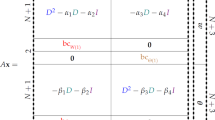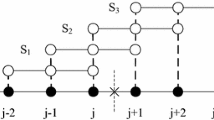Abstract
The stationary Wigner inflow boundary value problem (SWIBVP) is modeled as an optimization problem by using the idea of shooting method in this paper. To remove the singularity at \(v=0\), we consider a regularized SWIBVP, where a regularization constraint is considered along with the original SWIBVP, and a modified optimization problem is established for it. A shooting algorithm is proposed to solve the two optimization problems, involving the limited-memory BFGS (L-BFGS) algorithm as the optimization solver. Numerical results show that solving the optimization problems with respect to the SWIBVP with the shooting algorithm is as effective as solving the SWIBVP with Frensley’s numerical method (Frensley in Phys Rev B 36:1570–1580, 1987). Furthermore, the modified optimization problem gets rid of the singularity at \(v=0\), and preserves symmetry of the Wigner function, which implies the optimization modeling with respect to the regularized SWIBVP is successful.






Similar content being viewed by others
Data Availibility
The datasets generated during and/or analysed during the current study are available in the figshare repository, https://figshare.com/articles/dataset/data_file_zip/13022507
References
Wigner, E.: On the quantum correction for thermodynamic equilibrium. Phys. Rev. 40(5), 749–759 (1932)
Weinbub, J., Ferry, D.K.: Recent advances in Wigner function approach. Appl. Phys. Rev. 5(4), 041104 (2018)
Bardos, C., Caflisch, R.E., Nicolaenko, B.: The Milne and Kramers problems for the Boltzmann equation of a hard sphere gas. Commun. Pure Appl. Math. 39(3), 323–352 (1986)
Coron, F.: Computation of the asymptotic states for linear half space kinetic problems. Transp. Theory Stat. Phys. 19(2), 89–114 (1990)
Bobylev, A.V., Palczewski, A., Schneider, J.: On approximation of the Boltzmann equation by discrete velocity models. C. R. Acad. Sci. Paris Sér I(320), 639–644 (1995)
Palczewski, A., Schneider, J., Bobylev, A.V.: A consistency result for a discrete-velocity model of the Boltzmann equation. SIAM J. Numer. Anal. 34(5), 1865–1883 (1997)
Carrillo, J.A., Gamba, I.M., Majorana, A., Shu, C.-W.: A WENO-solver for the transient of devices: performance and comparisons with Monte Carlo methods. J. Comput. Phys. 184, 498–525 (2003)
Bernhoff, N.: On half-space problems for the discrete Boltzmann equation. Il nuovo cimento C, Societa italiana di fisica 33(1), 47–54 (2010)
Hu, Z., Li, R., Lu, T., Wang, Y., Yao, W.: Simulation of an \(n^{+}\)-\(n\)-\(n^{+}\) Diode by using globally-hyperbolically-closed high-order moment models. J. Sci. Comput. 59, 761–774 (2014)
Li, R., Lu, T., Yao, W.: Discrete kernel preserving model for 1D optical electron–phonon scattering. J. Sci. Comput. 62(2), 317–335 (2015)
Li, Q., Lu, J., Sun, W.: A convergent method for linear half-space kinetic equations. ESAIM Math. Model. Numer. Anal. 51(5), 1583–1615 (2017)
Yao, W., Lu, T.: Discrete kernel preserving model for 3D electron-optical phonon scattering under arbitrary band structures. J. Sci. Comput. 81(3), 2213–2236 (2019)
Frensley, W.R.: Wigner function model of a resonant-tunneling semiconductor device. Phys. Rev. B 36, 1570–1580 (1987)
Arnold, A., Lange, H., Zweifel, P.F.: A discrete-velocity, stationary Wigner equation. J. Math. Phys. 41(11), 7167–7180 (2000)
Barletti, L., Zweifel, P.F.: Parity-decomposition method for the stationary Wigner equation with inflow boundary conditions. Transp. Theory Stat. Phys. 30(4–6), 507–520 (2001)
Li, R., Lu, T., Sun, Z.P.: Stationary Wigner equation with inflow boundary conditions: will a symmetric potential yield a symmetric solution? SIAM J. Appl. Math. 70(3), 885–897 (2014)
Li, R., Lu, T., Sun, Z.P.: Parity-decomposition and moment analysis for stationary Wigner equation with inflow boundary condition. Front. Math. China 12(4), 907–919 (2017)
Jensen, K.L., Buot, F.A.: Numerical simulation of intrinsic bistability and high-frequency current oscillations in resonant tunneling structures. Phys. Rev. Lett. 66, 1078–1081 (1991)
Taj, D., Genovese, L., Rossi, F.: Quantum-transport simulations with the Wigner-function formalism: failure of conventional boundary-condition schemes. Europhys. Lett. 74(6), 1060–1066 (2006)
Jiang, H., Lu, T., Cai, W.: A device adaptive inflow boundary condition for Wigner equations of quantum transport. J. Comput. Phys. 258, 773–786 (2014)
Dorda, A., Schürrer, F.: A WENO-solver combined with adaptive momentum discretization for the Wigner transport equation and its application to resonant tunneling diodes. J. Comput. Phys. 284, 95–116 (2015)
Shao, S., Lu, T., Cai, W.: Adaptive conservative cell average spectral element methods for transient Wigner equation in quantum transport. Commun. Comput. Phys. 9(3), 711–739 (2011)
Furtmaier, O., Succi, S., Mendoza, M.: Semi-spectral method for the Wigner equation. J. Comput. Phys. 305, 1015–1036 (2016)
Xiong, Y., Chen, Z., Shao, S.: An advective-spectral-mixed method for time-dependent many-body Wigner simulations. SIAM J. Sci. Comput. 38(4), B491–B520 (2016)
Chen, Z., Xiong, Y., Shao, S.: Numerical methods for the Wigner equation with unbounded potential. J. Sci. Comput. 79(1), 345–368 (2019)
Cai, Z., Fan, Y., Li, R., Lu, T., Wang, Y.: Quantum hydrodynamic model by moment closure of Wigner equation. J. Math. Phys. 53(10), 103503 (2012)
Cai, Z., Fan, Y., Li, R., Lu, T., Yao, W.: Quantum hydrodynamic model of density functional theory. J. Math. Chem. 51(7), 1747–1771 (2013)
Rossi, F., Jacoboni, C., Nedjalkov, M.: A Monte Carlo solution of the Wigner transport equation. Semicond. Sci. Technol. 9(5S), 934–936 (1994)
Shifren, L., Ringhofer, C., Ferry, D.K.: A Wigner function-based quantum ensemble Monte Carlo study of a resonant tunneling diode. IEEE Trans. Electron Dev. 50(3), 769–773 (2003)
Stoer, J., Burlisch, R.: Introduction to Numerical Analysis. Springer, New York (1980)
Lu, T., Sun, Z.P.: Singularity-free numerical scheme for the stationary Wigner equation. J. Comput. Math. 37(2), 170–183 (2019)
Acknowledgements
This research was supported in part by the National Science Foundation of China (11671038, 11801183, 11901496), Project for Hunan National Applied Mathematics Center of Hunan Provincial Science and Technology Department (2020ZYT003).
Author information
Authors and Affiliations
Corresponding author
Additional information
Publisher's Note
Springer Nature remains neutral with regard to jurisdictional claims in published maps and institutional affiliations.
Appendices
Proof of Lemma 1
Proof
By the Whittaker–Shannon interpolation formula, P(v) can be reformulated as the series
where \(\{v_n: v_n=n\varDelta v+s,\varDelta v= \pi /B, n\in {\mathbb {Z}}\}\) are uniform discrete points with a shift s.
Let \({\mathcal {F}}[\cdot ]\) and \( {\mathcal {F}}^{-1}[\cdot ]\) stand for the Fourier transform and the corresponding inverse Fourier transform respectively. Define \(g(v)= P(v)\mathbin {*} Q(v)\), then it can be written as
where \({\widehat{P}}(y)={\mathcal {F}}[P(v)]\), \({\widehat{Q}}(y)={\mathcal {F}}[Q(v)]\) and
It is easy to see that \({\widehat{g}}(y)={\mathcal {F}}[g(v)]\) also has compact support on \([-B,B]\) and by the Whittaker–Shannon interpolation formula, we have
Denote Q(v; B) as the inverse Fourier transform of \({\widehat{Q}}(y)\chi _{[-B,B]}(y)\), i.e.,
Recalling the Whittaker–Shannon interpolation formula, Q(v; B) is reformulated as
where \({\widetilde{v}}_n= n\varDelta v\) and \(\varDelta v =\pi /B\).
Next, we give the value of \(g(v_n)\). Substituting (41) and (44) into the definition of \(g(v_n)\), we obtain
where \(\delta _{m,k}\) is the Kronecker delta function. \(\square \)
Proof of Theorem 1
Proof
If \(V(\frac{L}{2}+x) = V(\frac{L}{2}-x)\), then we have
that is to say,
Now we consider a final value problem
and an initial value problem
Introduce \({\varvec{z}}(x)={\varvec{f}}(\frac{L}{2}-x)\) , and the (FVP) (46) can be transformed into an initial value problem for \({\varvec{z}}(x)\) ,
which is equivalent to
by using the relation (45). Therefore, the (FVP) is equivalent to the (IVP*) if setting \({\varvec{z}}(x)={\varvec{f}}(\frac{L}{2}-x)\) in (46). Similarly, the (IVP) is also equivalent to the (IVP*) if setting \({\varvec{z}}(x)={\varvec{f}}(x-\frac{L}{2})\) in (47). In other word, if \(\varvec{\psi }(x)\) is a solution of the (IVP*), then the solution of the (FVP) is
and the solution of the (IVP) is
It is then concluded that \({\varvec{f}}(\frac{L}{2}-x) = {\varvec{f}}(\frac{L}{2}+x)\) for all \(x\in [0,L]\). \(\square \)
Rights and permissions
About this article
Cite this article
Sun, Z., Yao, W. & Lu, T. Optimization Modeling and Simulating of the Stationary Wigner Inflow Boundary Value Problem. J Sci Comput 85, 21 (2020). https://doi.org/10.1007/s10915-020-01338-2
Received:
Revised:
Accepted:
Published:
DOI: https://doi.org/10.1007/s10915-020-01338-2
Keywords
- The stationary Wigner equation
- Inflow boundary condition
- Shooting method
- Optimization problem
- Regularization




